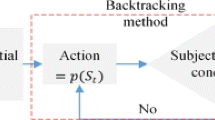Abstract
With the increasing application of unmanned aircraft in civil airspace, collision avoidance systems for unmanned aircraft are becoming more and more important and valuable. An ideal collision avoidance system gives the aircraft an optimal strategy for choosing flight actions to avoid collision risks when it detects other aircraft nearby. Currently the general approach to generating collision avoidance logics is to model the problem as a partially observable Markov decision process (POMDP), and then synthesize an optimal policy. However, the existing systems require the precise position information of the intruder aircraft to generate the avoidance actions and ignore the effects of the flight path changes, which may result in its lower robustness or a wasting of flying resources.
In this paper, we construct a collision avoidance system based on limited information that reduces the variations from the original flight path. We use POMDPs to model the collision avoidance system with only the destination information of our own aircraft and rough information about the intruder position and generate the collision resolution logic. We implement the collision avoidance module, embed it into the real unmanned aircraft system over PX4 flight control platform and demonstrate the effectiveness of our system by flight simulation.
Access this chapter
Tax calculation will be finalised at checkout
Purchases are for personal use only
Similar content being viewed by others
Notes
- 1.
- 2.
https://dev.px4.io/master/en/index.html, PX4 Development Guide.
References
Bai, H., Hsu, D., Kochenderfer, M.J., Lee, W.S.: Unmanned aircraft collision avoidance using continuous-state POMDPs. In: Durrant-Whyte, H.F., Roy, N., Abbeel, P. (eds.) Robotics: Science and Systems VII, University of Southern California, Los Angeles, CA, USA, 27–30 June 2011 (2011). https://doi.org/10.15607/RSS.2011.VII.001. http://www.roboticsproceedings.org/rss07/p01.html
Bai, H., Hsu, D., Lee, W., Vien, N.: Monte Carlo value iteration for continuous-state POMDPs. Algorithmic Found. Robot. IX 68, 175–191 (2010). https://doi.org/10.1007/978-3-642-17452-0_11
Hauskrecht, M.: Value-function approximations for partially observable Markov decision processes. J. Artif. Intell. Res. 13, 33–94 (2000). https://doi.org/10.1613/jair.678
Hazeghi, K., Puterman, M.: Markov decision processes: discrete stochastic dynamic programming. J. Am. Stat. Assoc. 90, 392 (1995). https://doi.org/10.2307/2291177
Julian, K.D., Lopez, J., Brush, J.S., Owen, M.P., Kochenderfer, M.J.: Policy compression for aircraft collision avoidance systems. In: 2016 IEEE/AIAA 35th Digital Avionics Systems Conference (DASC), pp. 1–10 (2016)
Kaelbling, L., Littman, M., Cassandra, A.: Planning and acting in partially observable stochastic domains. Artif. Intell. 101, 99–134 (1998). https://doi.org/10.1016/S0004-3702(98)00023-X
Kamen, E.W., Su, J.K.: Optimal estimation. In: Grimble, M.J., Johnson, M.A. (eds.) Introduction to Optimal Estimation. Advanced Textbooks in Control and Signal Processing, Springer, London (1999). https://doi.org/10.1007/978-1-4471-0417-9_3
Kochenderfer, M., Chryssanthacopoulos, J.: Robust airborne collision avoidance through dynamic programming (2011)
Kochenderfer, M., Holland, J., Chryssanthacopoulos, J.: Next generation airborne collision avoidance system. Lincoln Lab. J. 19, 17–33 (2012)
Kuchar, J., Drumm, A.: The traffic alert and collision avoidance system. Lincoln Lab. J. 16(2), 277–296 (2007)
Kurniawati, H., Hsu, D., Lee, W.S.: SARSOP: efficient point-based POMDP planning by approximating optimally reachable belief spaces. In: Robotics: Science and Systems IV (2008)
Manfredi, G., Jestin, Y.: An introduction to ACAS Xu and the challenges ahead. In: DASC, pp. 1–9 (2016). https://doi.org/10.1109/DASC.2016.7778055
Pineau, J., Gordon, G., Thrun, S.: Point-based value iteration: an anytime algorithm for POMDPs. In: IJCAI, pp. 1025–1032 (2003)
Porta, J., Vlassis, N., Spaan, M., Poupart, P.: Point-based value iteration for continuous POMDPs. J. Mach. Learn. Res. 7, 2329–2367 (2006)
Puterman, M.L.: Markov Decision Processes: Discrete Stochastic Dynamic Programming. Wiley Series in Probability and Statistics, vol. 594. Wiley, Hoboken (2005)
Shani, G., Pineau, J., Kaplow, R.: A survey of point-based POMDP solvers. Auton. Agent. Multi-Agent Syst. 27, 1–51 (2013). https://doi.org/10.1007/s10458-012-9200-2
Smith, T., Simmons, R.: Point-based POMDP algorithms: improved analysis and implementation. In: UAI, pp. 542–549 (2005)
Sondik, E.J.: The optimal control of partially observable Markov processes over the infinite horizon: discounted costs. Oper. Res. 26(2), 282–304 (1978). https://doi.org/10.1287/opre.26.2.282
Sutton, R.S., Barto, A.G.: Reinforcement Learning - An Introduction. Adaptive Computation and Machine Learning. MIT Press, Cambridge (1998). http://www.worldcat.org/oclc/37293240
Temizer, S., Kochenderfer, M., Kaelbling, L., Lozano-Perez, T., Kuchar, J.: Collision avoidance for unmanned aircraft using Markov decision processes. In: AIAA Guidance, Navigation, and Control Conference (2010). https://doi.org/10.2514/6.2010-8040
Thrun, S.: Monte Carlo POMDPs. In: NIPS, pp. 1064–1070 (1999)
Acknowledgments
The authors are very thankful to Xuechao Sun and Junwen Li for helpful discussion and the assembly of the Pixhawk drone. This work has been supported by the Guangdong Science and Technology Department (grant no. 2018B010107004), the Natural Science Foundation of Guangdong Province (grant no. 2019A1515011689), and the National Natural Science Foundation of China (grant nos. 61761136011, 61532019, 61836005).
Author information
Authors and Affiliations
Corresponding author
Editor information
Editors and Affiliations
Rights and permissions
Copyright information
© 2020 Springer Nature Switzerland AG
About this paper
Cite this paper
Feng, W., Huang, CC., Turrini, A., Li, Y. (2020). Modelling and Implementation of Unmanned Aircraft Collision Avoidance. In: Pang, J., Zhang, L. (eds) Dependable Software Engineering. Theories, Tools, and Applications. SETTA 2020. Lecture Notes in Computer Science(), vol 12153. Springer, Cham. https://doi.org/10.1007/978-3-030-62822-2_4
Download citation
DOI: https://doi.org/10.1007/978-3-030-62822-2_4
Published:
Publisher Name: Springer, Cham
Print ISBN: 978-3-030-62821-5
Online ISBN: 978-3-030-62822-2
eBook Packages: Computer ScienceComputer Science (R0)




